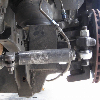motohobo
Member
- Joined
- December 12, 2016
- Messages
- 17
- Reaction score
- 5
- City, State
- Maryland
- Year, Model & Trim Level
- 1994 Explorer XL
First, the good news- referring to this thread:
 www.explorerforum.com
www.explorerforum.com
Fitted 1st gen positive and negative cables are available at Autozone for under $50 for the pair -- best price anywhere. Part numbers are at the end of this thread. I just installed them and they fit. These are the same cables Partsgeeks and NAPA has, just ~$25 cheaper and local pickup rather than long wait times for shipping.
Bad news - after the install I'm getting zero power anywhere in the vehicle. I'm a novice wrt electricals and could use some help. Some details:
* The battery reads 12.4V.
* Power at the fender relay reads 12.4V at the left-hand terminal and nothing at the right hand one.
* The terminal at the starter end of the positive cable reads 12.4V when the battery is connected, so I'm assuming the main ground connections on the negative cable are OK.
* The negative cable shipped with crimp connectors instead of the plug that goes into the two-pronged jack behind the battery. I cut those off and soldered the plug to the new negative cable.
* I connected the thinner positive wire to the fender relay terminal on the right and the thicker one to the terminal on the left -- pretty sure this is the way it's supposed to be but can't remember exactly.
So my first two questions are:
* Shouldn't there be 12.4V to both terminals of the fender relay? Maybe that connecting cable is bad - should I try bridging the positive across both those terminals? Would doing that cause any very bad things to happen?
* Where does that two-pole ground connector behind the battery go and how can I test whether that ground is getting to its destination?
I'm going to start testing grounds and checking fuses now, but if I'm missing something obvious maybe someone could put me out of my misery. I've had this vehicle for 10 years and have fixed or replaced alternator, serpentine, brake MC, calipers and brake lines, etc etc etc, but this cable thing is by far the biggest PITA of all. Anyway, those AZ cables come from a company called GP Sorensen. The part numbers are:
Positive: DA72-4UA
Negative: BA49-4CTL
Any help greatly appreciated...
Van
91-94X Battery Cables
...Save yourself some head aches and do not attempt to put ends on cables, but instead, replace the whole cable...The cables commonly corrode inside the sheathing.... _________________________________________________________________________________ ...Click, click, click... ..This is a good...
Fitted 1st gen positive and negative cables are available at Autozone for under $50 for the pair -- best price anywhere. Part numbers are at the end of this thread. I just installed them and they fit. These are the same cables Partsgeeks and NAPA has, just ~$25 cheaper and local pickup rather than long wait times for shipping.
Bad news - after the install I'm getting zero power anywhere in the vehicle. I'm a novice wrt electricals and could use some help. Some details:
* The battery reads 12.4V.
* Power at the fender relay reads 12.4V at the left-hand terminal and nothing at the right hand one.
* The terminal at the starter end of the positive cable reads 12.4V when the battery is connected, so I'm assuming the main ground connections on the negative cable are OK.
* The negative cable shipped with crimp connectors instead of the plug that goes into the two-pronged jack behind the battery. I cut those off and soldered the plug to the new negative cable.
* I connected the thinner positive wire to the fender relay terminal on the right and the thicker one to the terminal on the left -- pretty sure this is the way it's supposed to be but can't remember exactly.
So my first two questions are:
* Shouldn't there be 12.4V to both terminals of the fender relay? Maybe that connecting cable is bad - should I try bridging the positive across both those terminals? Would doing that cause any very bad things to happen?
* Where does that two-pole ground connector behind the battery go and how can I test whether that ground is getting to its destination?
I'm going to start testing grounds and checking fuses now, but if I'm missing something obvious maybe someone could put me out of my misery. I've had this vehicle for 10 years and have fixed or replaced alternator, serpentine, brake MC, calipers and brake lines, etc etc etc, but this cable thing is by far the biggest PITA of all. Anyway, those AZ cables come from a company called GP Sorensen. The part numbers are:
Positive: DA72-4UA
Negative: BA49-4CTL
Any help greatly appreciated...
Van










